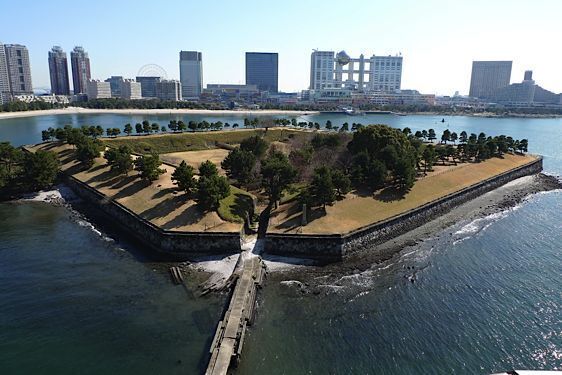Shinagawa Battery Islands: Difference between revisions
No edit summary |
No edit summary |
||
| Line 14: | Line 14: | ||
|City=Tokyo | |City=Tokyo | ||
|Prefecture=Tokyo | |Prefecture=Tokyo | ||
|Notes=Walk across the Rainbow Bridge to get the best views. After visiting here you could also take a river boat bus from the landing next to the Odaiba Kaihin Park up to Asakusa. I'm not sure if this is a separate castle or an extension of Edo Castle, but most of my materials list it separately, so I will too. | |Notes=Walk across the Rainbow Bridge to get the best views. After visiting here you could also take a river boat bus from the landing next to the Odaiba Kaihin Park up to Asakusa. I'm not sure if this is a separate castle or an extension of Edo Castle, but most of my materials list it separately, so I will too. | ||
|History=The Tokugawa Government commissioned Egawa Hidetatsu in 1853 to build several fortresses in Tokyo Bay to protect Edo from foreign ships, namely Commodore Perry, who also arrived that same year. Egawa's plan originally consisted of 11 man-made islands and three additional batteries placed around the mouth of the Sumida River. In just over a year, 6 of the original plan were completed, but due to a lack of funds and emphasis being placed on other fortifications, such as Goryokaku, the remainder of the plan was abandoned. Since WWII, most of these islands were destroyed or absorbed by fill-in projects such as the Tennoz Isle area. Only islands #3 and #6 remain today. Island #3 is now connected to the Odaiba Kaihin park by a landbridge. You can get a good view of each island by walking across the Rainbow Bridge. | |History=The Tokugawa Government commissioned Egawa Hidetatsu in 1853 to build several fortresses in Tokyo Bay to protect Edo from foreign ships, namely Commodore Perry, who also arrived that same year. Egawa's plan originally consisted of 11 man-made islands and three additional batteries placed around the mouth of the Sumida River. In just over a year, 6 of the original plan were completed, but due to a lack of funds and emphasis being placed on other fortifications, such as Goryokaku, the remainder of the plan was abandoned. Since WWII, most of these islands were destroyed or absorbed by fill-in projects such as the Tennoz Isle area. Only islands #3 and #6 remain today. Island #3 is now connected to the Odaiba Kaihin park by a landbridge. You can get a good view of each island by walking across the Rainbow Bridge. | ||
|Year Visited=2011 | |Year Visited=2011 | ||
|AddedJcastle=2011 | |||
|Japanese Notes=レインボーブリッジの遊歩道を歩いて、台場を見下ろすのが最も眺望がいいです。訪れた後でお台場海浜公園の近くの水上バスで浅草まで行ってはいかがでしょうか。 | |Japanese Notes=レインボーブリッジの遊歩道を歩いて、台場を見下ろすのが最も眺望がいいです。訪れた後でお台場海浜公園の近くの水上バスで浅草まで行ってはいかがでしょうか。 | ||
|Visits=March 5, 2011 | |Visits=March 5, 2011 | ||
|GPSLocation=35.63362, 139.77201 | |||
}} | }} | ||
Revision as of 22:00, 7 October 2017
Walk across the Rainbow Bridge to get the best views. After visiting here you could also take a river boat bus from the landing next to the Odaiba Kaihin Park up to Asakusa. I'm not sure if this is a separate castle or an extension of Edo Castle, but most of my materials list it separately, so I wil
History
The Tokugawa Government commissioned Egawa Hidetatsu in 1853 to build several fortresses in Tokyo Bay to protect Edo from foreign ships, namely Commodore Perry, who also arrived that same year. Egawa's plan originally consisted of 11 man-made islands and three additional batteries placed around the mouth of the Sumida River. In just over a year, 6 of the original plan were completed, but due to a lack of funds and emphasis being placed on other fortifications, such as Goryokaku, the remainder of the plan was abandoned. Since WWII, most of these islands were destroyed or absorbed by fill-in projects such as the Tennoz Isle area. Only islands #3 and #6 remain today. Island #3 is now connected to the Odaiba Kaihin park by a landbridge. You can get a good view of each island by walking across the Rainbow Bridge.
Field Notes
Walk across the Rainbow Bridge to get the best views. After visiting here you could also take a river boat bus from the landing next to the Odaiba Kaihin Park up to Asakusa. I'm not sure if this is a separate castle or an extension of Edo Castle, but most of my materials list it separately, so I will too.
Gallery
| Castle Profile | |
|---|---|
| English Name | Shinagawa Battery Islands |
| Japanese Name | 品川台場 |
| Founder | Egawa Hidetatsu |
| Year Founded | 1853 |
| Castle Type | Flatland |
| Castle Condition | Ruins only |
| Designations | Next 100 Castles, National Historic Site |
| Historical Period | Edo Period |
| Features | stone walls |
| Visitor Information | |
| Access | Odaiba Kaihin Koen (Yurikamome); 15 min walk |
| Hours | |
| Time Required | |
| URL | Castle Website |
| Location | Tokyo, Tokyo |
| Coordinates | 35.63362, 139.77201 |
|
|
|
| Admin | |
| Added to Jcastle | 2011 |
| Admin Year Visited | 2011 |
| Admin Visits | March 5, 2011 |



















